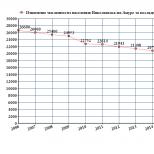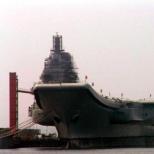Is the current in the Zusha River fast or slow? Is the current in the Zusha River fast or slow? Is the current fast or slow?
Much in the world depends on the majority. The climate on the planet as well. Almost 70% of the surface globe takes up water. It determines the fate of humanity
Cross-sectional area of the ACC (5)(the only one that crosses all the longitudes of the world) is huge: the depth is up to 4000 m, and the width is up to 2000 km. But it does not flow quickly - the speed does not exceed 0.7 km/h.

The most powerful currents of the World Ocean(water consumption* in m 3 /s)
* Flow rate - the volume of water flowing per unit time through the cross section of the flow
(5)
Antarctic circumpolar current 150,000,000 m 3 /s
(3)
Gulf Stream 100,000,000 m 3 /s
(2)
Kuroshio 80,000,000 m 3 /s
Global Ocean Conveyor connects the upper (in depth) part of the ocean water column with the lower. The length of the conveyor path is 40 thousand kilometers.
Deep water travels this path in 1.5–2 thousand years.
Solar energy reaches the Earth's surface unevenly: the maximum is at the equator, the minimum is at the poles. Thanks to the conveyor belt, ocean currents transfer heat from where there is more of it to where there is less of it, that is, from the equator to the poles.
If there were no oceans, average temperature the Earth's surface would be 36 °C lower than today and would be only –21 °C

Fastest currents**
(1)
SOMALIAN SUMMER 75 CM/S
(2)
KUROSHIO 50 CM/S
(3)
GULF STREAM 40 CM/S
(4)
AGULYASSKOE 34 CM/S
(5)
ACC 28 CM/S
** Dana average speed currents
Gulf Stream flow, according to some estimates, 40 times more than the flow of all the world's rivers combined
Currents are divided into warm and cold. But the division is relative. Thus, in the “warm” North Cape Current in the Barents Sea, the water temperature in summer is up to 8 °C, and in the “cold” Canary Current in the Atlantic - all year round from 12 to 26 °C
Average wave height in the Atlantic Ocean Lately increases by about a centimeter per year. This indicates widespread climate change
To the question whether the current of the Volga is fast or slow, asked by the author Adelina Kuasheva the best answer is The nature of the Volga flow
Features of lowland rivers
2. Low flow speed
3. Wide shallow valley
Current direction
The place where the Akhtuba branch separates is sometimes taken as the beginning of the Volga delta. It is more correct, however, to count the beginning of the delta from the place where the Buzan branch separated. From here the Volga is divided into a dense network of branches and channels. The Volga delta is one of the largest deltas in our country. Numerous branches, channels, islands, lakes (called here ilmens and hollows) and sand ridges (Berovsky hillocks) occupy a total space of over 13,000 km2.
Answer from Neurologist[guru]
When we go up it's slow, but when we go down it's fast
Answer from Alexandra Gurgaeva[newbie]
The current on the Volga is slow
Answer from Put down[guru]
The average current speed is low - from 2 to 6 km/h.
Answer from Staff[guru]
The Volga is a flat river, the current is slow.
Answer from Marina Loginova[newbie]
The Volga is flat.
so the current is slow
Answer from Vika Balandina[newbie]
slow
Answer from Elizaveta Viktorovna[newbie]
average
Answer from Olga Afanasyeva[newbie]
gne54ennekuapavyvacuv45
Answer from Ksunchic Richkova[newbie]
The Volga is a flat river, which means it has a slow flow.
Answer from Maxim Goncharov[active]
The nature of the Volga flow
The Volga is a typical lowland river.
Features of lowland rivers
1. Small difference in height between mouth and source
2. Low flow speed
3. Wide shallow valley
Current direction
The main direction of the Volga flow is to the south.
Flowing within the East European Plain, the Volga is a classic example of a lowland river. Its longitudinal profile is close to the so-called equilibrium profile. The average slope is only 0.06°/oo. The drop is especially small in the lower reaches, where it does not exceed 0.02°/oo. According to the size and nature of the current, the Volga is usually divided into three parts: the upper current (Upper Volga) - from the source to the city of Shcherbakov, the middle current (Middle Volga) - from the city of Shcherbakov to the mouth of the Kama and the lower current ( Lower Volga) - from the confluence of the Kama to the mouth.
IN upper reaches, within the Valdai Upland, the Volga passes through the chain of Upper Volga lakes - Verkhit, Sterzh, Vselug, Peno and Volgo. At the source of the lake. In the Volga River, in the middle of the last century (1843), a dam was built - the Upper Volga Beishlot - designed to enhance the river's nutrition during low water periods and maintain navigable depths. Major tributaries Upper Volga - Selizharovka, Tverda, Mologa and Sheksna. During the years of Stalin's five-year plans, the Upper Volga was reconstructed, that is, radically reorganized. Three powerful hydroelectric power stations were built here: Ivankovskaya, Uglichskaya and Shcherbakovskaya. The dams of these hydroelectric power plants turned the Upper Volga into a chain of lakes and reservoirs, among which the Rybinsk Reservoir is the largest in the world. Waters: this reservoir was flooded by the lower reaches of pp. Mologa and Scheksny and the entire Mologo-Sheksna interfluve.
In the middle reaches, below the town of Shcherbakov, the river becomes even more full-flowing; here a number of large tributaries flow into it, the most important of which are the Oka, Unzha, Vetluga and Sura. The regime of the river's middle course has changed significantly and is highly dependent on releases from Rybinsk Reservoir. Below the confluence of the Kama, which in its water content is almost as good as the Volga itself, the latter becomes especially full-flowing. The width of the valley reaches 20-30 km. In the area of the city of Kuibyshev, the Volga, bending Zhiguli Mountains, forms a giant bend - Samara onion, where the valley narrows to 2-3 km. The asymmetrical structure of the valley is characteristic: the right bank is high and steep everywhere, and the left bank is flat and low. The valley expands especially strongly below Stalingrad. Here the Volga on the left separates the first branch - the river. Akhtuba, which then flows as an independent stream parallel to the main channel of the Volga.
The vast space between the Volga and Akhtuba, cut by numerous channels and old rivers, is called the Volga-Akhtuba floodplain. Spills within the Volga-Akhtuba floodplain reach 20-30 km. The Lower Volga receives only relatively small tributaries: Samara, Bolshoi Irgiz and Eruslan.
The place where the Akhtuba branch separates is sometimes taken as the beginning of the Volga delta. It is more correct, however, to count the beginning of the delta from the place where the Buzan branch separated. From here the Volga is divided into a dense network of branches and channels. The Volga delta is one of the largest deltas in our country. Numerous branches, channels, islands, lakes (called here ilmens and hollows) and sand ridges (Berovsky hillocks) occupy a total space of over 13,000 km2.
Ob, one of the largest rivers in Russia and the whole world; the third most water-bearing river in the Russian Federation. Formed by the confluence of the Biya and Katun rivers in Altai, it flows from South to North across the territory Western Siberia and flows into the Ob Bay of the Kara Sea. The length of the river is 3650 km, if we count the source of the Irtysh, then 5410 km. The pool area is 2990 thousand square meters. km, according to this characteristic the river ranks first in the Russian Federation. Most of the basin (approximately 85%) is located on the West Siberian Plain. A significant part of the basin is covered with forests and occupied by swamps. More than 50 species of fish live in the waters of the Ob, some of them commercial. Most valuable species: sturgeon, nelma, sterlet, muksun, whitefish, peled, whitefish. River flow The river crosses several climatic zones. In the south, in the upper reaches of the Ob, grapes, watermelons and melons grow, then in the north, in the lower reaches of the Ob, this is the tundra and the harsh Arctic. The Novosibirsk Reservoir is located in the southern part of the Ob. The Novosibirsk hydroelectric power station was built from 1950 to 1961; during the creation of the reservoir it was flooded most of the city of Berdsk and many villages. The upper section of the basin is located in the mountains; here the river has a well-developed valley with many floodplain terraces. Until the mouth of the Charysha River, the Ob flows on low, uncovered banks; the riverbed is replete with channels, rifts, and islands. Closer to Barnaul, the floodplain and valley expand. From Barnaul to the town of Kamenya-on-Obi, the valley expands to 10 km and is asymmetrical with steep left and gentle right slopes; The wide floodplain is cut by channels, oxbow lakes and lakes. Near the city of Kamenya-on-Obi, the valley and floodplain narrow to kilometers; in the riverbed there are areas with rocky ledges. In the southern part of the city of Novosibirsk, the river is blocked by a dam, which formed a reservoir - the Ob Sea. After Novosibirsk, the valley widens significantly and reaches 20 km at the mouth of the Tom, with a depth of up to 6 m. Below the mouth of the Tom and Chulym, the Ob River becomes large full-flowing river and until its confluence with the Irtysh it flows within the taiga zone. The valley is up to 50 km wide with a floodplain covered with a dense network of channels. Depth up to 8 m.
The largest tributaries: Ket, Tom, Chulym, Tym, Tromyegan, Vakh, Lyamin, Nazim, Shegarka, Chaya, Vasyugan, Parabel, Bolshoi Yugan, Bolshoi Salym, Irtysh.After the confluence of the Irtysh, the Ob turns to the North. The valley is very wide, more than 50 km, with a low left bank and a steep right bank. In the area of Peregrebnoye and Salekhard it narrows to 4-8 km. The extensive left-bank floodplain is cut up by channels, branches, lakes, and in high water reaches a width of up to 40-50 km. From the Irtysh to Peregrebnoye the Ob flows in one deep channel with a depth of at least 4 m, then the river is divided into Bolshaya and Malaya Ob. After their confluence, the Ob channel has depths of more than 10 m.
Complete group work assignments.
1) Make a list of water bodies in your region.
There are up to 2,000 rivers and streams, of which 323 are more than 10 km long. The rivers of the Moscow region belong entirely to the Volga basin.
The largest rivers in the Moscow region are the Oka and Moskva with their tributaries. Third large river Klyazma region.
Rivers: Moscow, Yauza, Klyazma, Setun, Skhodnya, Khimka.
Lakes: Beloe, Kosinskie lakes, Svyatoe (lake, Moscow), Trostenskoye, Nerskoye, Krugloye
Swamps: Black, Great, Holy, Oak
2) Fill out the tables.
Table 1. Description of the river.
| Description plan | Basic information |
| 1. Title |
Moscow - river |
| 2. Where is the source of the river? | on the Smolensk-Moscow Upland in the Starkovsky swamp |
| 3. What kind of current: fast or slow? | the current is slow |
| 4. Tributaries | Skhodnya, Beggar, Khimka, Kotlovka, Chura, Tarakanovka |
| 5. Where does the river flow? | into the Oka River in the city of Kolomna |
| 6. How the river changes in different times of the year | freezes in November - December, opens in March - April |
| 7. Plants and animals of the river | birches, meadow grasses, perch, roach, bream, bleak |
| 8. Human use of the river | for city water supply |
| 9. How people influence the river | the river is polluted by sewage and waste from factories |
| 10. What people do to protect the river | treatment facilities are in place, monitoring the level of pollution |
Table 2. Description of Moscow - rivers
| Description plan | Basic information |
| 1. Title |
Moscow - river |
| 2. General characteristics | length 473 km, location - middle river in Central Russia, in the Moscow region, Moscow and, for a short distance, in the Smolensk region, the left tributary of the Oka (Volga basin) |
| 3. Nature of the channel, width | winding, from 80 to 120 m |
| 4. Coastal flora | birch groves, forests, meadows |
| 5. Fish resources | 35 types of fish: roach, bream |
| 6. Economic importance | water supply, transport |
| 7. Tourism and recreation | walks, excursions, fishing |
| 8. The beauty of the river | your impression |
Use your textbook to create a diagram.
The importance of water resources in nature and human life
Using the diagram, talk about the importance of water resources.
Think about what environmental problems are expressed by these signs. Formulate and write down.
Water pollution industrial waste |
|
Pollution of water resources with garbage and human waste products |
|
| Getting into rivers and lakes with groundwater chemical substances, such as fertilizers and pesticides from fields | |
| Water pollution from gasoline and motor oil when washing cars in rivers |
Suggest conservation measures for class discussion that would help solve these problems.
The Question Ant and the Wise Turtle ask you to write a letter to your peers from other cities and villages, urging you to take care of water resources. In your letter, try to prove that water resources
in every corner of the country they need protection.Boys and girls ! All water resources necessary for the life of people, animals and plants. Life is not possible without water! The water is home to a variety of fish and other animals that participate in a variety of food chains. In addition, man has learned to use water resources in his economic activity
. Protect water resources: keep the water clean, clear springs and streams, protect plants and animals. Save water! The average speed of ocean currents is 5 km. at one o'clock. But there are also those who significantly exceed this speed and carry with them great amount
water. What are the strongest currents you can find in the ocean?
Gulf Stream

This is the most powerful warm current in the World Ocean. It begins in the Sargasso Sea, then flows along the coast of the United States to California. Here the Gulf Stream turns towards Europe. The speed of the water flow is 2.5 meters per second. The maximum width of the Gulf Stream reaches 200 kilometers, and its depth is 800 meters.
Rice. 1. Gulf Stream The water temperature in the Gulf Stream ranges from 24 degrees Celsius in winter to 28 in summer. The warm influence of the Gulf Stream softens the climate European countries
on the Atlantic coast.
Antarctic Circumpolar Current This flow is also called flow Western winds
. It is located in the Southern Hemisphere, around Antarctica.
The current of the Western Winds crosses as many as three oceans.
Its power is three times greater than the power of the Gulf Stream, so it can rightfully be considered the most powerful current in the World Ocean. The length of the flow of the Western Winds reaches 30 thousand kilometers, and the maximum width is 2500 kilometers. The water speed is approximately 58 meters per second. In a second, the ACC carries about 200 million tons of water - this is more than the volume of rivers on the globe.TOP 1 article

who are reading along with this
Rice. 2. Antarctic Circumpolar Current
El Niño This beautiful name translated from Spanish as baby, child. However, the El Niño current is very treacherous and destructive for coastal countries. This is the warmest current in the Pacific Ocean. Its water temperature is 9 degrees Celsius higher than that of environment
. This leads to the formation of hurricane-force winds in the coastal zone. As a result, long rainfalls, droughts, and fires occur on the coast. From El Niño currents

millions of people are suffering and the global economy is suffering enormous damage.
Rice. 3. The destructive El Niño current
This current passes through the eastern part of the Atlantic Ocean. Its speed reaches 2 km. at one o'clock. The current carries about 40 million cubic meters of water per second. Due to its proximity to the mainland, coastal countries enjoy a warm climate.
Kuroshio
This is a powerful warm current Pacific Ocean. Its width is 170 km, and its depth reaches 700 m. In terms of power, this current is slightly weaker than the Gulf Stream. It passes by Japan and Kuril Islands. In the north it merges with the waters of the North Pacific Current, reaching Alaska.





